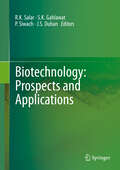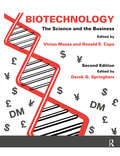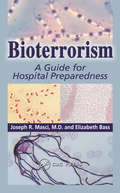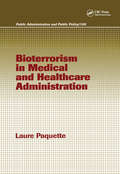- Table View
- List View
Biotechnology: Prospects and Applications
by R.K. Salar, S.K. Gahlawat, P. Siwach and J.S. DuhanBiotechnology: Prospects and Applications covers the review of recent developments in biotechnology and international authorship presents global issues that help in our understanding of the role of biotechnology in solving important scientific and societal problems for the benefit of mankind and environment. A balanced coverage of basic molecular biology and practical applications, relevant examples, colored illustrations, and contemporary applications of biotechnology provide students and researchers with the tools and basic knowledge of biotechnology. In our effort to introduce students and researchers to cutting edge techniques and applications of biotechnology, we dedicated specific chapters to such emerging areas of biotechnology as Emerging Dynamics of Brassinosteroids Research, Third generation green energy, Bioremediation, Metal Organic Frameworks: New smart materials for biological application, Bioherbicides, Biosensors, Fetal Mesenchymal Stem Cells and Animal forensics. Biotechnology: Prospects and Applications will be highly useful for students, teachers and researchers in all disciplines of life sciences, agricultural sciences, medicine, and biotechnology in universities, research stations and biotechnology companies. The book features broader aspects of the role of biotechnology in human endeavor. It also presents an overview of prospects and applications while emphasizing modern, cutting-edge, and emerging areas of biotechnology. Further, it provides the readers with a comprehensive knowledge of topics in food and agricultural biotechnology, microbial biotechnology, environmental biotechnology and animal biotechnology. The chapters have been written with special reference to the latest developments in above broader areas of biotechnology that impact the biotechnology industry. A list of references at the end of each chapter is provided for the readers to learn more about a particular topic. Typically, these references include basic research, research papers, review articles and articles from the popular literature.
Biotechnology Proteins to PCR: A Course in Strategies and Lab Techniques
by David W. Burden Donald B. WhitneyBiotechnology: Recent Trends and Emerging Dimensions
by Atul Bhargava Shilpi SrivastavaBiotechnology is a multidisciplinary field encompassing microbiology, bichemistry, genetics, molecular biology, chemistry, immunology, cell and tissue culture physiology. This book describes the recent developments in these areas. Current research topics such as Quorum sensing, Integrons, Phytomining are discussed, which would serve as an excellent reference work for both academicians and researchers in the field.
Biotechnology - The Science and the Business
by Vivian Moses Ronald E. Cape Derek G. SpringhamBiotechnology has not stood still since 1991 when the first edition of Biotechnology - The Science and the Business was published. It was the first book to treat the science and business of technology as an integrated subject and was well received by both students and business professionals. All chapters in this second edition have been updated and revised and some new chapters have been introduced, including one on the use of molecular genetic techniques in forensic science. Experts in the field discuss a range of biotechnologies, including pesticides, the flavor and fragrance industry, oil production, fermentation and protein engineering. On the business side, subjects include managing, financing, and regulation of biotechnology. Some knowledge of the science behind the technologies is assumed, as well as a layperson's view of buying and selling. As with the first edition, it is expected that this book will be of interest to biotechnology undergraduates, postgraduates and those working in the industry, along with students of business, economics, intellectual property law and communications.
Biotechnology - The Science and the Business
by Derek G. Springham Vivian Moses Ronald E. CapeBiotechnology has not stood still since 1991 when the first edition of Biotechnology - The Science and the Business was published. It was the first book to treat the science and business of technology as an integrated subject and was well received by both students and business professionals. All chapters in this second edition have been updated and revised and some new chapters have been introduced, including one on the use of molecular genetic techniques in forensic science. Experts in the field discuss a range of biotechnologies, including pesticides, the flavor and fragrance industry, oil production, fermentation and protein engineering. On the business side, subjects include managing, financing, and regulation of biotechnology. Some knowledge of the science behind the technologies is assumed, as well as a layperson's view of buying and selling. As with the first edition, it is expected that this book will be of interest to biotechnology undergraduates, postgraduates and those working in the industry, along with students of business, economics, intellectual property law and communications.
Biotechnology & the Environment: International Regulation
by Iver P. Cooper Bruce F. Mackler Jeffrey N. GibbsBiotelemetrie: Angewandte biomedizinische Technik (Anaesthesiologie und Intensivmedizin Anaesthesiology and Intensive Care Medicine #78)
by H. HuttenBiotensegrity: The Structural Basis of Life 2nd Edition
by Graham Melvin ScarrThe emerging science of biotensegrity provides a fresh context for rethinking our understanding of human movement, but its complexities can be formidable. Biotensegrity: The Structural Basis of Life, Second edition - now with full color illustrations throughout - explores and explains the concept of biotensegrity and provides an understanding and appreciation of anatomy and physiology in the light of the latest research findings.The reader learns that biotensegrity is an evolving science which gives researchers, teachers, and practitioners across a wide range of specialisms, including bodyworkers and movement teachers, a deeper understanding of the structure and function of the human body. They are then able to develop clinical practice and skills in light of this understanding, leading to more effective therapeutic approaches, with the aim of improved client outcomes.The second edition provides expanded coverage of the developmental and therapeutic aspects of biotensegrity. Coverage now includes:A more thorough look at life's internal processesClosed kinematic chains as the new biomechanicsEmbryological development as an evolutionary processThe human body as a constantly evolving system based on a set of unchanging principlesEmergence, heterarchies, soft-matter and small-world networksA deeper look at what constitutes the therapeutic process
Bioterrorism: A Guide for Hospital Preparedness
by Joseph R. Masci M.D. Elizabeth BassIn the battle against bioterrorism, one of the greatest challenges is finding the ideal balance between complacency and overreaction. The goal is to be so well prepared that we can prevent catastrophic outcomes in the event of a bioterrorist attack, while strengthening our ability to prevent and treat naturally-occurring infectious diseases.Bioterr
Bioterrorism: A Guide for Hospital Preparedness
by Joseph R. Masci M.D. Elizabeth BassIn the battle against bioterrorism, one of the greatest challenges is finding the ideal balance between complacency and overreaction. The goal is to be so well prepared that we can prevent catastrophic outcomes in the event of a bioterrorist attack, while strengthening our ability to prevent and treat naturally-occurring infectious diseases.Bioterr
Bioterrorism and Infectious Agents: A New Dilemma for the 21st Century (Emerging Infectious Diseases of the 21st Century)
by I. W. Fong Ken AlibekCompiled by two leading experts in the field, this volume provides a concise, timely, and authoritative review of some of the most problematic infections of the new century. It presents issues and new ideas for preventing and controlling infectious diseases.
Bioterrorism and Infectious Agents: A New Dilemma for the 21st Century (Emerging Infectious Diseases of the 21st Century)
by I. W. Fong Kenneth AlibekCompiled by two leading experts in the field, this volume provides a concise, timely, and authoritative review of some of the most problematic infections of the new century. It presents issues and new ideas for preventing and controlling infectious diseases.
Bioterrorism in Medical and Healthcare Administration
by Laure PaquetteBioterrorism in Medical and Healthcare Administration provides an efficient method to identify, manage, and control transformations in the provision of health services during elevated levels of bioterrorist threat - offering step-by-step procedures and templates to prepare and implement a coordinated response to high-alert situations. This reference proposes an efficient method to identify, manage, and control transformations in the provision of health services during elevated levels of bioterrorist threat - offering step-by-step procedures and templates to prepare and implement a coordinated response to high-alert situations.
Biotherapeutic Agents and Infectious Diseases
by Christina M. Surawicz Lynne V. McFarland Gary W. ElmerAuthoritative investigators active in the discovery, development, and application of biological anti-infective agents concisely review their use and potential in preventing and treating human disease. Focusing on biotherapeutic entities that have been tested in controlled studies, the prominent experts illuminate the scientific underpinnings of their therapeutic power, assess their possible risks in the treatment of infectious diseases, and outline the research needed to better define their effectiveness. In addition, they also consider how biotherapeutic agents may be genetically engineered for maximum intestinal and vaginal production of bioactive substances in vivo. Biotherapeutic Agents and Infectious Diseases brings together all the evidence needed to understand and capitalize on the considerable promise of this significant new class of biotherapeutic entities.
Biotherapy - History, Principles and Practice: A Practical Guide to the Diagnosis and Treatment of Disease using Living Organisms
by Martin Grassberger, Ronald A. Sherman, Olga S. Gileva, Christopher M.H. Kim and Kosta Y. MumcuogluBiotherapy is defined as the use of living organisms in the treatment and diagnosis of human and animal diseases. This volume is an evocative exploration of the history, scientific basis and practical use of the major biotherapy modalities. The authors provide researchers and practitioners interested in this field, with cutting-edge material on the latest key advances in the following fields of biotherapy: Maggot Therapy, Hirudotherapy, Bee Venom Therapy, Apitherapy, Ichthyotherapy, Helminth Therapy, Phage Therapy, Animal Assisted Therapy, Canine Olfactory Detection. In addition, the authors provide with their chapters an extensive bibliography that represents a state-of-the-art survey of the literature. Comprehensive and current, this fresh volume of reviews is an essential resource for professionals who need to stay ahead of the game in the exciting field of biotherapy.
Biothermodynamics: Principles and Applications
by Mustafa Ozilgen Esra Sorguven OnerOver the past several decades there has been increasing research interest in thermodynamics as applied to biological systems. This concerns topics such as muscle work and internal energy such as fat and starch. Applications of the first and second laws of thermodynamics to the human body are important to dieticians and health science experts, and applications of these concepts to the animal body are a major concern of animal scientists. This book covers these key topics, which are typically not covered in classic or traditional thermodynamics texts used in mechanical and chemical engineering.
Biothermodynamics: Principles and Applications
by Mustafa Ozilgen Esra Sorguven OnerOver the past several decades there has been increasing research interest in thermodynamics as applied to biological systems. This concerns topics such as muscle work and internal energy such as fat and starch. Applications of the first and second laws of thermodynamics to the human body are important to dieticians and health science experts, and applications of these concepts to the animal body are a major concern of animal scientists. This book covers these key topics, which are typically not covered in classic or traditional thermodynamics texts used in mechanical and chemical engineering.
Biotic Stress Management of Crop Plants using Nanomaterials (Advances in Bionanotechnology)
by Krishna Kant Mishra Santosh KumarThis book summarizes nanotechnology-based agricultural research for crop productivity and the management of various plant pathogens. It deals with the application of nano-molecules for quick, cost-effective, and precise plant disease diagnostic procedures, plant pests and disease management, nano-pesticides, and nano-diagnostics. Further, it explains nanomaterials for biotic stress management, with an insight into the synthesis and modification of nanomaterials and their potential applications in different domains for disease management. Features include:• Compilation of current research on the Nanomaterials as well as their versatile applications in plant biotic stress management.• Description of the role of nanomaterials as enzyme-mimicking nanoparticles, nano-pesticides, nano-fertilizers, and nanomaterials.• Review of day-to-day problems related to crop plants, their diagnostics, and stress management.• Exploration of trends in nanomaterial utility in diagnostics, enzyme-mimicking, and crop protection, and their possible role in plant disease management.• Study of pertinent nanomaterials including synthetic strategies, properties, chemistry, and applications. This book is aimed at researchers and graduate students in plant pathology, genetic engineering, environmental science, botany, bioengineering, and nanotechnology.
Biotic Stress Management of Crop Plants using Nanomaterials (Advances in Bionanotechnology)
This book summarizes nanotechnology-based agricultural research for crop productivity and the management of various plant pathogens. It deals with the application of nano-molecules for quick, cost-effective, and precise plant disease diagnostic procedures, plant pests and disease management, nano-pesticides, and nano-diagnostics. Further, it explains nanomaterials for biotic stress management, with an insight into the synthesis and modification of nanomaterials and their potential applications in different domains for disease management. Features include:• Compilation of current research on the Nanomaterials as well as their versatile applications in plant biotic stress management.• Description of the role of nanomaterials as enzyme-mimicking nanoparticles, nano-pesticides, nano-fertilizers, and nanomaterials.• Review of day-to-day problems related to crop plants, their diagnostics, and stress management.• Exploration of trends in nanomaterial utility in diagnostics, enzyme-mimicking, and crop protection, and their possible role in plant disease management.• Study of pertinent nanomaterials including synthetic strategies, properties, chemistry, and applications. This book is aimed at researchers and graduate students in plant pathology, genetic engineering, environmental science, botany, bioengineering, and nanotechnology.
Biotransport: Principles and Applications
by Robert J. Roselli Kenneth R. DillerIntroduction to Biotransport Principles is a concise text covering the fundamentals of biotransport, including biological applications of: fluid, heat, and mass transport.
Biotribology: Emerging Technologies and Applications (Emerging Materials and Technologies)
by T. V. V. L. N. Rao Salmiah Binti Kasolang Xie Guoxin Jitendra Kumar Katiyar Ahmad Majdi Abdul RaniBiotribology includes tribological phenomena of natural and implant surface interactions under relative motion in the human body. Biotribology: Emerging Technologies and Applications disseminates ideas and research trends in biotribology and presents pioneering recent research advances impacting the field, focusing on the roles of mathematics, chemistry, physics, materials, and mechanical engineering. Discusses lubrication of joint replacements, computational modeling of biotribology and multibody biomechanical models Describes metal-organic frameworks, medical friction pairs, and electrochemical techniques to tribocorrosion tests Covers state of the art and future technological developments and applications, as well as challenges and opportunities Biotribology is an important and growing field, and the topics covered in this book will be of great interest to the international tribology community, appealing to readers working in the fields of materials science, biomedical engineering, biotechnology, mechanical engineering, and related areas.
Biotribology: Emerging Technologies and Applications (Emerging Materials and Technologies)
by T.V.V.L.N. Rao Salmiah Binti Kasolang Xie Guoxin Jitendra Kumar Katiyar Ahmad Majdi Abdul RaniBiotribology includes tribological phenomena of natural and implant surface interactions under relative motion in the human body. Biotribology: Emerging Technologies and Applications disseminates ideas and research trends in biotribology and presents pioneering recent research advances impacting the field, focusing on the roles of mathematics, chemistry, physics, materials, and mechanical engineering. Discusses lubrication of joint replacements, computational modeling of biotribology and multibody biomechanical models Describes metal-organic frameworks, medical friction pairs, and electrochemical techniques to tribocorrosion tests Covers state of the art and future technological developments and applications, as well as challenges and opportunities Biotribology is an important and growing field, and the topics covered in this book will be of great interest to the international tribology community, appealing to readers working in the fields of materials science, biomedical engineering, biotechnology, mechanical engineering, and related areas.
Biowaste and Biomass in Biofuel Applications (Mathematical Engineering, Manufacturing, and Management Sciences)
by Yashvir Singh Vladimir Strezov Prateek NegiThis book reflects the new dimension of biofuel production from its introductory principles to the advancements from a future prospective. It summarizes the rationale for changes in liquid fuel utilization and the selection of new technologies to make biofuel cost-effective and move toward a carbon-neutral approach. It provides an evidence-based outline of how additives and nanotechnology chemically change biofuels' quality and effectiveness, including new and innovative approaches, such as nanomaterials and various nano-additives. Features: It provides an overview of biowaste as a sustainable source in the field of biofuel production It includes effective conversion parameters of the biowaste feedstocks and their classification It summarizes current research into the development and exploitation of new biofuel sources It discusses the improvement of pilot scale scalability, chemical processing, and design flow It presents relevant and realistic global explanations of biowaste management techniques for biofuels This book is aimed at senior undergraduate and graduate students, and researchers in bioprocessing, chemical engineering, and biotechnology.
Biowaste and Biomass in Biofuel Applications (Mathematical Engineering, Manufacturing, and Management Sciences)
by Yashvir Singh Vladimir Strezov Prateek NegiThis book reflects the new dimension of biofuel production from its introductory principles to the advancements from a future prospective. It summarizes the rationale for changes in liquid fuel utilization and the selection of new technologies to make biofuel cost-effective and move toward a carbon-neutral approach. It provides an evidence-based outline of how additives and nanotechnology chemically change biofuels' quality and effectiveness, including new and innovative approaches, such as nanomaterials and various nano-additives. Features: It provides an overview of biowaste as a sustainable source in the field of biofuel production It includes effective conversion parameters of the biowaste feedstocks and their classification It summarizes current research into the development and exploitation of new biofuel sources It discusses the improvement of pilot scale scalability, chemical processing, and design flow It presents relevant and realistic global explanations of biowaste management techniques for biofuels This book is aimed at senior undergraduate and graduate students, and researchers in bioprocessing, chemical engineering, and biotechnology.


















